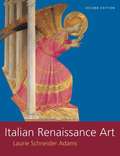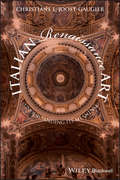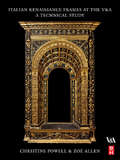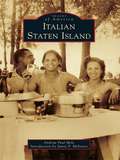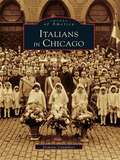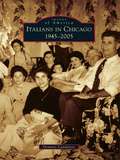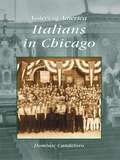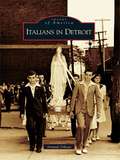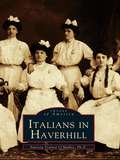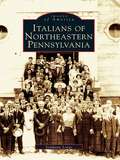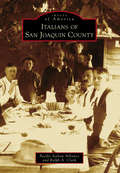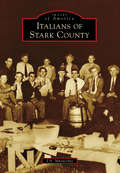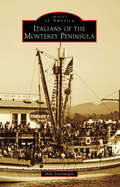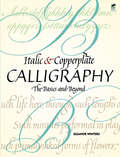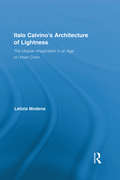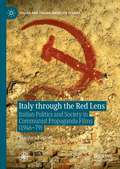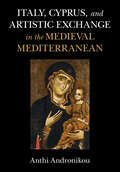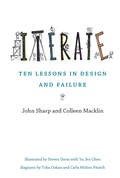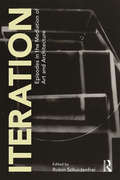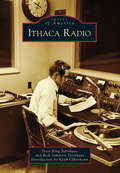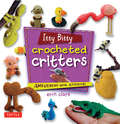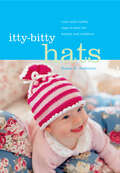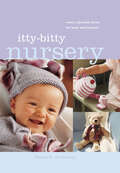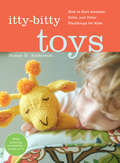- Table View
- List View
Italian Renaissance Art (Icon Editions Series #Second Edition)
by Laurie Schneider AdamsNow thoroughly revised and updated throughout, featuring extended discussions of Mannerism and the expanding role of women in the visual arts and significant illustration program enhancements, Italian Renaissance Art is a readable, student-friendly, lavishly-illustrated introduction to one of the greatest periods of artistic genius in western history.
Italian Renaissance Art: Understanding its Meaning
by Christiane L. Joost-GaugierRichly illustrated, and featuring detailed descriptions of works by pivotal figures in the Italian Renaissance, this enlightening volume traces the development of art and architecture throughout the Italian peninsula in the fifteenth and sixteenth centuries. A smart, elegant, and jargon-free analysis of the Italian Renaissance – what it was, what it means, and why we should study it Provides a sustained discussion of many great works of Renaissance art that will significantly enhance readers’ understanding of the period Focuses on Renaissance art and architecture as it developed throughout the Italian peninsula, from Venice to Sicily Situates the Italian Renaissance in the wider context of the history of art Includes detailed interpretation of works by a host of pivotal Renaissance artists, both well and lesser known
Italian Renaissance Frames at the V&A
by Christine Powell Zoe AllenThis visually stunning and technically detailed book is an in-depth analysis of the materials and techniques used on thirty eight of the V&A's Renaissance frames. The book will teach the reader to recognise frame style, structure and surface decoration of the period, as well as additions and alterations and later frames in the style. * First detailed technical analysis of the V&A's most important Renaissance frames * Highly illustrated with 100 + colour photos of front back and details, digital reconstructions, section profiles, and illustrations of frame types, joints and mouldings. * Provides a comparative reference for Renaissance frames in other publications Christine Powell has worked at the V&A since 1993. She is a Senior Furniture Conservator specialising in gilt wood European Furniture, mirror and picture frames. She has also worked at The National Gallery London for seven years as conservator working on European painted and gilt wood altarpieces and frames and The Wallace Collection for two years on European gilt wood frames and furniture. She has taught and published articles on the history, materials techniques and conservation of gilding. Christine studied furniture making and restoration of furniture at the London College of Furniture (latterly the Metropolitan University) including wood finishing, carving and gilding. Before this she worked in private practice for furniture restoration and special paint effects firms. She also attended Epsom School of Art and Design. Zoë Allen first joined the V&A in 2000 to work on gilt wooden objects for the British Galleries and returned to the V&A in 2003 where she has worked since as Frames and Gilded Furniture Conservator. Before joining the V&A full time she worked as a conservator for both public institutions, such as English Heritage, and private practices including projects at the Royal Academy, St Paul’s Cathedral and Somerset House. Zoë has published articles on her work. After a first degree in French Literature, Zoë studied conservation at the City & Guilds of London Art School. Her training covered the conservation of objects made from wood, stone and other sculptural materials, gilding and decorative surfaces. Internships included the National Institute for Restoration, Croatia, the Royal Collection, London and the Museum of London.
Italian Science Fiction: The Other in Literature and Film (Studies in Global Science Fiction)
by Simone Brioni Daniele ComberiatiThis book explores Italian science fiction from 1861, the year of Italy’s unification, to the present day, focusing on how this genre helped shape notions of Otherness and Normalness. In particular, Italian Science Fiction draws upon critical race studies, postcolonial theory, and feminist studies to explore how migration, colonialism, multiculturalism, and racism have been represented in genre film and literature. Topics include the role of science fiction in constructing a national identity; the representation and self-representation of “alien” immigrants in Italy; the creation of internal “Others,” such as southerners and Roma; the intersections of gender and race discrimination; and Italian science fiction’s transnational dialogue with foreign science fiction. This book reveals that though it is arguably a minor genre in Italy, science fiction offers an innovative interpretive angle for rethinking Italian history and imagining future change in Italian society.
Italian Staten Island (Images of America)
by Andrew Paul Mele James P. MolinaroThe great wave of European immigration in the late 19th and early 20th centuries brought more than four million Italians to America. It was one of the greatest mass emigrations in world history, and many settled in Staten Island. Following the opening of the Verrazano-Narrows Bridge in 1964, the island experienced another great influx of Italian immigrants, this time from the other boroughs of New York City. This new wave was responsible for doubling the island population by the year 2000. Italian Americans are evident in every avocation and in each corner of Staten Island society, with achievers in education, business, government, medicine, and sports and entertainment. Italian Staten Island chronicles the traditions, culture, and heritage of Italian Americans through more than 200 photographs.
Italians in Chicago: 1945-2005 (Images of America)
by Dominic CandeloroThe stories of Chicago's Italian communities are an important part of the rich and diverse mosaic of Chicago history. As a rail center, an industrial center, and America's fastest growing major city, Chicago offered opportunities for immigrants from all nations. Italians in Chicago presents an intriguing narrative record of the earliest beginnings of Italian communities in the city, going back to the 1850s. It explores the lives of ten significant members of the Chicago Italian-American community.This book is a collaborative, cumulative effort, and gives glimpses and echoes of what occurred in the Italian-American past in Chicago. Including vintage images and tales of such individuals as Father Armando Pierini, Anthony Scariano, and Joe Bruno, and groups such as the Aragona Club and the Maria Santissima Lauretana Society, this collection uncovers the challenges and triumphs of these Italian immigrants.
Italians in Chicago: 1945-2005 (Images of America)
by Dominic CandeloroMore than 25,000 Italian immigrants came to Chicago after 1945. The story of their exodus and reestablishment in Chicago touches on war torn Italy, the renewal of family and paesani connections, the bureaucratic challenges of the restrictive quota system, the energy and spirit of the new immigrants, and the opportunities and frustrations in American society. Drawn from scores of family albums, these intimate snapshots tell the story of the unique and universal saga of immigration, a core theme in American and Italian history.
Italians in Chicago: 1945-2005 (Voices of America)
by Dominic CandeloroThe stories of Chicago's Italian communities are an important part of the rich and diverse mosaic of Chicago history. As a rail center, an industrial center, and America's fastest growing major city, Chicago offered opportunities for immigrants from all nations. Italians in Chicago presents an intriguing narrative record of the earliest beginnings of Italian communities in the city, going back to the 1850s. It explores the lives of ten significant members of the Chicago Italian-American community.This book is a collaborative, cumulative effort, and gives glimpses and echoes of what occurred in the Italian-American past in Chicago. Including vintage images and tales of such individuals as Father Armando Pierini, Anthony Scariano, and Joe Bruno, and groups such as the Aragona Club and the Maria Santissima Lauretana Society, this collection uncovers the challenges and triumphs of these Italian immigrants.
Italians in Detroit (Images of America)
by Armando DelicatoPeople of Italian descent have been present in Detroit since Alfonso Tonti, second-in-command to Antoine Cadillac, participated in the founding of the city in 1701. By the close of the 19th century, the trickle of Italian immigrants had become a torrent, as thousands rushed to the growing industrial center. Settling on the lower east side, the community grew rapidly, especially north and east into Macomb County. Italians in Detroit did not remain in a "little Italy," but mingled with the diverse population of the city. Through a combination of hard work and strong family and community ties, the Italians of Detroit have achieved their dreams of a better life. They have met the challenges of living in a new land while nurturing the culture of the old country. The challenge that remains is to nurture a love ofheritage among young Italian Americans as the immigrant generation fades.
Italians in Haverhill
by Patricia Trainor O’malleyItalian immigrants became permanent residents of Haverhill in the 1870s. The original Genoese first drew their relatives and friends from their home area to join them. Over the next few decades, they were joined by families from the central province of Abruzzi and from the towns and villages around Naples. Immigrants from parts of southern Italy, such as Calabria and Apulia and Sicily, settled here. All of the Italians, whether northern or southern, brought with them their culture, their vitality, their love of music, and their close family ties. Using over two hundred thirty vintage photographs, Italians in Haverhill takes a photographic walk through the exciting history of these immigrants. The images bring back to life representatives of more than two hundred families, whose descendants still live in the area. Here are the fruit sellers and shoe workers, the mothers and their children, the ball players and the musicians, the lawyers and doctors, and the bankers and civic leaders who make up the rich heritage of this important ethnic group.
Italians of Northeastern Pennsylvania (Images of America)
by Stephanie LongoEvery Labor Day weekend, hundreds of thousands of people flock to Courthouse Square in Scranton for the largest ethnic festival in northeastern Pennsylvania: La Festa Italiana. The Italians of this region have been proudly celebrating their heritage since their arrival in this country with traditional festivals, including La Corsa dei Ceri in Jessup and Dunmore's procession in honor of St. Rocco. Using vintage and recent photographs, Italians of Northeastern Pennsylvania shows how the Italian immigrants to this area, some of whom arrived with little more than the clothes on their back, became well-respected community leaders. Through hard work and dedication, they have made northeastern Pennsylvania into an area that defines the term "ethnic pride."
Italians of San Joaquin County (Images of America)
by Ralph A. Clark Pacific Italian AllianceItalians were among the first European settlers in California, as fishermen from Italy arrived in the 1830s. After gold was discovered in 1848, immigrants from all over the world came for the opportunity that California presented. For the Italians, they encountered a terrain and climate so similar to their homeland that many stayed on to make California their new home. In San Joaquin County, the Italian influence remains profound, with the immigrants and their descendants helping develop the area's cultural, agricultural, and business climate into what it is today. The legacy of the Italian pioneers has enriched San Joaquin County in immeasurable ways. Every aspect of life here has been touched, molded, and made better by this industrious group who came to a distant land to make a better life.
Italians of Stark County (Images of America)
by J. A. MusacchiaImages of America: Italians of Stark County focuses on Italian immigration into Stark County beginning in the late 1800s. At the time, Stark County's urban hub of Canton and the surrounding communities were in the middle of a thriving expansion driven by industry, transportation, and manufacturing. Along with this growth came the need for labor, with immigration filling many of those needs. Italians came to Stark County to work in the steel mills, in the coal mines, and on the railroad, as well as to start their own small businesses. Once established, Italian families began to replicate the community foundations from their native land, and in turn these foundations reinforced embedded values: family, food, religion, music, and freedom.
Italians of the Monterey Peninsula
by Mike VentimigliaSince the early 1900s, Monterey was known for its fishing, mostly for salmon and the abalone that was plentiful in Monterey Bay. The migration of the Sicilian Italian community is credited for reaping what was called the "Silver Harvest." The Silver Harvest is the name that was given to the fishing of sardines in Monterey, which mostly was done by the Sicilian Italians who established the working fabric in the sardine industry for nearly five decades. Most of that generation is gone, and only a few are memorialized in books. It is this author's attempt to capture the working class that made Monterey the "Sardine Capital of the World."
Italic and Copperplate Calligraphy: The Basics and Beyond (Lettering, Calligraphy, Typography)
by Eleanor WintersIn recent years, calligraphy has evolved from an esoteric art form to an everyday pursuit for artists, students, and amateurs. This guide for novices with some experience offers the chance to advance to the next level. Well-illustrated, step-by-step instructions by an expert calligrapher explain every detail of the two most popular calligraphic alphabets. Author Eleanor Winters introduces the Italic hand, which originated during the Renaissance, and the Copperplate style, which dominated European calligraphy during the eighteenth century. Her three-part approach begins with a review of the basics, advancing to variations in letter size, form, weight, and flourishes. It concludes with a wealth of advice on layout and design as well as inspiration for original projects.
Italo Calvino's Architecture of Lightness: The Utopian Imagination in An Age of Urban Crisis (Routledge Studies in Twentieth-Century Literature)
by Letizia ModenaThis study recovers Italo Calvino's central place in a lost history of interdisciplinary thought, politics, and literary philosophy in the 1960s. Drawing on his letters, essays, critical reviews, and fiction, as well as a wide range of works--primarily urban planning and design theory and history--circulating among his primary interlocutors, this book takes as its point of departure a sweeping reinterpretation of Invisible Cities. Passages from Calvino's most famous novel routinely appear as aphorisms in calendars, posters, and the popular literature of inspiration and self-help, reducing the novel to vague abstractions and totalizing wisdom about thinking outside the box. The shadow of postmodern studies has had a similarly diminishing effect on this text, rendering up an accomplished but ultimately apolitical novelistic experimentation in endless deconstructive deferrals, the shiny surfaces of play, and the ultimately rigged game of self-referentiality. In contrast, this study draws on an archive of untranslated Italian- and French-language materials on urban planning, architecture, and utopian architecture to argue that Calvino's novel in fact introduces readers to the material history of urban renewal in Italy, France, and the U.S. in the 1960s, as well as the multidisciplinary core of cultural life in that decade: the complex and continuous interplay among novelists and architects, scientists and artists, literary historians and visual studies scholars. His last love poem for the dying city was in fact profoundly engaged, deeply committed to the ethical dimensions of both architecture and lived experience in the spaces of modernity as well as the resistant practices of reading and utopian imagining that his urban studies in turn inspired.
Italy through the Red Lens: Italian Politics and Society in Communist Propaganda Films (1946–79) (Italian and Italian American Studies)
by Gianluca FantoniThis book offers the first comprehensive analysis of the role of cinema in the communication strategy of the Italian Communist party (the PCI). It examines the entire period during which the party had a systematic and organized approach to cinematographic production, starting with the early experiments in 1946 and concluding with the closure of PCI film company Unitelefilm at the end of the 1970s. Its analysis sheds light on a range of issues, such as the relationship between the party and Italian intellectuals, the Stalinist imprint of the Italian Communist Party and the historical significance of the Salerno turn, the PCI’s relationship with the student movements in 1968 and 1977, and the PCI’s response to the rise in political violence in the 1970s. Ultimately, the book demonstrates that cinema was essential to the PCI’s propaganda effort.
Italy, Cyprus, and Artistic Exchange in the Medieval Mediterranean
by Anthi AndronikouIn this volume Anthi Andronikou explores the social, cultural, religious and trade encounters between Italy and Cyprus during the late Middle Ages, from ca. 1200 -1400, and situates them within several Mediterranean contexts. Revealing the complex artistic exchange between the two regions for the first time, she probes the rich but neglected cultural interaction through comparison of the intriguing thirteenth-century wall paintings in rock-cut churches of Apulia and Basilicata, the puzzling panels of the Madonna della Madia and the Madonna di Andria, and painted chapels in Cyprus, Lebanon, and Syria. Andronikou also investigates fourteenth-century cross-currents that have not been adequately studied, notably the cult of Saint Aquinas in Cyprus, Crusader propaganda in Santa Maria Novella in Florence, and a unique series of icons crafted by Venetian painters working in Cyprus. Offering new insights into Italian and Byzantine visual cultures, her book contributes to a broader understanding of cultural production and worldviews of the medieval Mediterranean.
Iterate: Ten Lessons in Design and Failure
by John Sharp Colleen MacklinHow to confront, embrace, and learn from the unavoidable failures of creative practice; with case studies that range from winemaking to animation. Failure is an inevitable part of any creative practice. As game designers, John Sharp and Colleen Macklin have grappled with crises of creativity, false starts, and bad outcomes. Their tool for coping with the many varieties of failure: iteration, the cyclical process of conceptualizing, prototyping, testing, and evaluating. Sharp and Macklin have found that failure—often hidden, covered up, a source of embarrassment—is the secret ingredient of iterative creative process. In Iterate, they explain how to fail better. After laying out the four components of creative practice—intention, outcome, process, and evaluation—Sharp and Macklin describe iterative methods from a wide variety of fields. They show, for example, how Radiolab cohosts Jad Abumrad and Robert Krulwich experiment with radio as a storytelling medium; how professional skateboarder Amelia Bródka develops skateboarding tricks through trial and error; and how artistic polymath Miranda July explores human frailty through a variety of media and techniques. Whimsical illustrations tell parallel stories of iteration, as hard-working cartoon figures bake cupcakes, experiment with levitating office chairs, and think outside the box in toothbrush design (“let's add propellers!”). All, in their various ways, use iteration to transform failure into creative outcomes. With Iterate, Sharp and Macklin offer useful lessons for anyone interested in the creative process. Case Studies: Allison Tauziet, winemaker; Matthew Maloney, animator; Jad Abumrad and Robert Krulwich, Radiolab cohosts; Wylie Dufresne, chef; Nathalie Pozzi, architect, and Eric Zimmerman, game designer; Andy Milne, jazz musician; Amelia Bródka, skateboarder; Baratunde Thurston, comedian; Cas Holman, toy designer; Miranda July, writer and filmmaker
Iteration: Episodes in the Mediation of Art and Architecture
by Robin SchuldenfreiThis edited volume considers the ways in which multiple stages, phases, or periods in an artistic or design process have served to arrive at the final artifact, with a focus on the meaning and use of the iteration. To contextualize iteration within artistic and architectural production, this collection of essays presents a range of close studies in art, architectural and design history, using archival and historiographical research, media theory, photography, material studies, and critical theory. It examines objects as unique yet mutable works by examining their antecedents, successive exemplars, and their afterlives—and thus their role as organizers or repositories of meaning. Key are the roles of writing, the use of media, and relationships between object, image, and reproduction. This volume asks how a closer look at iteration reveals new perspectives into the production of objects and the production of thought alike. Written by an international team of contributors, offering a range of perspectives, it looks broadly at meaning and insight offered by the iteration—for processes of design, for historical research, and for the reception of creative works.
Ithaca Radio
by Keith Olbermann Rick Sommers Steinhaus Peter King SteinhausFrom Long Island to Fiji, college students flocked to the sleepy little town of Ithaca to learn the how-tos and how-not-tos of broadcasting. From that influx came some of the future leaders and celebrities of the broadcasting industry. Television stars were born here, and some of radio's future stars were nurtured to succeed in an industry that impacts the daily lives of Americans. Ithaca's rich broadcasting history includes two college radio stations and several locally owned and operated stations. From the Greaseman to Keith Olbermann, Ithaca was the launch pad for numerous successful careers in music, talk, news, business, and satellite radio. Through vintage photographs, Ithaca Radio shares a history of local radio and some of the great voices that have called Ithaca home.
Itty Bitty Crocheted Critters
by Erin ClarkWhile the demand for Amigurumi just keeps getting bigger, these incredibly cute crocheted critters have just gotten smaller!Voodoo Maggie (AKA Erin Clark), the author of Voodoo Maggie's Adorable Amigurumi, has taken her yarn craft to the micro-level and stitched together a new menagerie of mini Amigurmi that are so darn cute-and tiny-that you might not want to part with any of them. Erin's crochet patterns are so easy to follow that you'll be able to make enough to satisfy an obvious demand from your friends and family. Erin even provides instructions on how to display these tiny Japanese crochet creatures in their own crochet-decorated terrarium. Itty Bitty Crocheted Critters features foolproof instructions on how to make twenty of Voodoo Maggie's most popular mini Amigurumi characters, including:Big Eared Fennec FoxSlow Moving SlothRed PandaTusked NarwhalMiniature MooseTiny TapirThese irresistible little guys are guaranteed to bring a smile to anyone's face. Get ready to "Awwwww!"Step-by-step photos and instructions to create the projects; includes instructions on terrarium displays; individual patterns can cost $5 each so this is a $100 value.
Itty-Bitty Hats: Cute and Cuddly Caps to Knit for Babies and Toddlers
by Susan B. AndersonBeautifully rendered, heartbreakingly adorable, and wonderfully wacky knitted caps for newborns and toddlers Thirty-eight million Americans knit, and that number grows every day. The baby hat is the perfect project for knitters of any level, with enchanting patterns that are easy enough for rank beginners but also interesting enough for the most accomplished needle wielders, in yarns that range from silk and linen to cashmere and mohair. Susan Anderson’s Itty-Bitty Hats presents thirty-eight irresistible designs for infants and toddlers—fun, hip, creative patterns with decorative flourishes that are witty, whimsical, and undeniably unique. The projects are arranged by order of difficulty and accompanied by beautiful photographs, instructive how-to illustrations, and utterly clear instructions (with no confusing abbreviations or insider shorthand). Anderson also provides an indispensable introductory section on stitches, materials, equipment, terminology, and techniques, allowing even the most inexperienced knitter to get started confidently. Made for boys and girls, by parents and grandparents, aunts and even uncles, and, of course, best friends, the handmade hat is the perfect shower or birth or birthday gift—and Itty-Bitty Hats is the perfect gift for any knitter.
Itty-Bitty Nursery: Sweet, Adorable Knits for the Baby and Beyond
by Susan B. AndersonA feast of gorgeous projects, shown on gorgeous kids in gorgeous photos. At sleep, at play, in the nursery, and on the go, adorable babies need adorable knits. And here are 40 gloriously unique projects that manage to be utterly charming, fabulous, and usable all at the same time. Baby sets and toys; stroller blankets, jackets, and mittens; and a pure and sweet layette are just the tip of the knitting frenzy that is Itty-Bitty Nursery. Picture cute garden mice on an amazing mobile and a knitted clothesline of miniature knitwear adorning the nursery. Coo at the baby sporting a striped hat called "Frenchie" or Mom with her Fruit Loops felted bag. Marvel at the amazing Cupcake Tea Set and the Three Pigs and a Wolf finger puppets, both perfect for the toddler at play. All of the projects are fresh, lively, and fun. With precisely illustrated instructions, there's something here for every level of knitter, from the greenest beginner to the most experienced craftsperson.
Itty-Bitty Toys: How to Knit Animals, Dolls, and Other Playthings for Kids
by Susan B. AndersonAdorable hand-knit playthings, featuring clever twists on classics and enchanting reversibles and interactive toys.Kids love toys, and toys you make yourself are extra-special. If you could buy these imaginative playthings in stores, they would fly off the shelves! This book features stuffed animals, including a luscious lamb and a gigantic giraffe, and finger-puppet fruits that will delight babies and toddlers. With step-by-step directions, clear diagrams and drawings, and gorgeous photographs, knitters of all levels will find it easy to make the Pull-Toy Mama Duck and Ducklings, the set of Russian nesting dolls, and the Princess and the Pea Set. Even older kids will enjoy these, as well as the Felted Bouncy Ball, a felted version of a Super Ball that's perfect for indoor play. A series of five reversible toys—a frog that turns into a turtle, a mouse that changes into a cat, an egg in a nest that transforms into a blue bird, and so on—showcases the creativity that makes Susan B. Anderson a rising star in the knitting world.
